Strategic Asset Management: Literature Review of Infrastructure
VerifiedAdded on 2021/04/21
|16
|4224
|98
Report
AI Summary
This report presents a literature review on strategic infrastructure and asset management, emphasizing the importance of a strategic approach to enhance organizational performance. It begins with an introduction to strategic infrastructure and asset management, followed by an examination of strategy and performance, and the significance of the resource-based view (RBV) for infrastructure organizations. The report then explores a conceptual framework for identifying essential skills in asset management, detailing steps such as defining the role of asset management, aligning infrastructure asset management goals, identifying core processes, delineating challenges, and distilling crucial skills. The review highlights the need for organizations to focus on internal factors like resources and capabilities to achieve a competitive advantage, particularly in the face of rapid business environment changes. The report also discusses the kinetic and heterogeneous advantages that can lead to improved, sustainable, and superior performance, emphasizing the need for organizations to adapt and innovate to maintain their competitive edge.
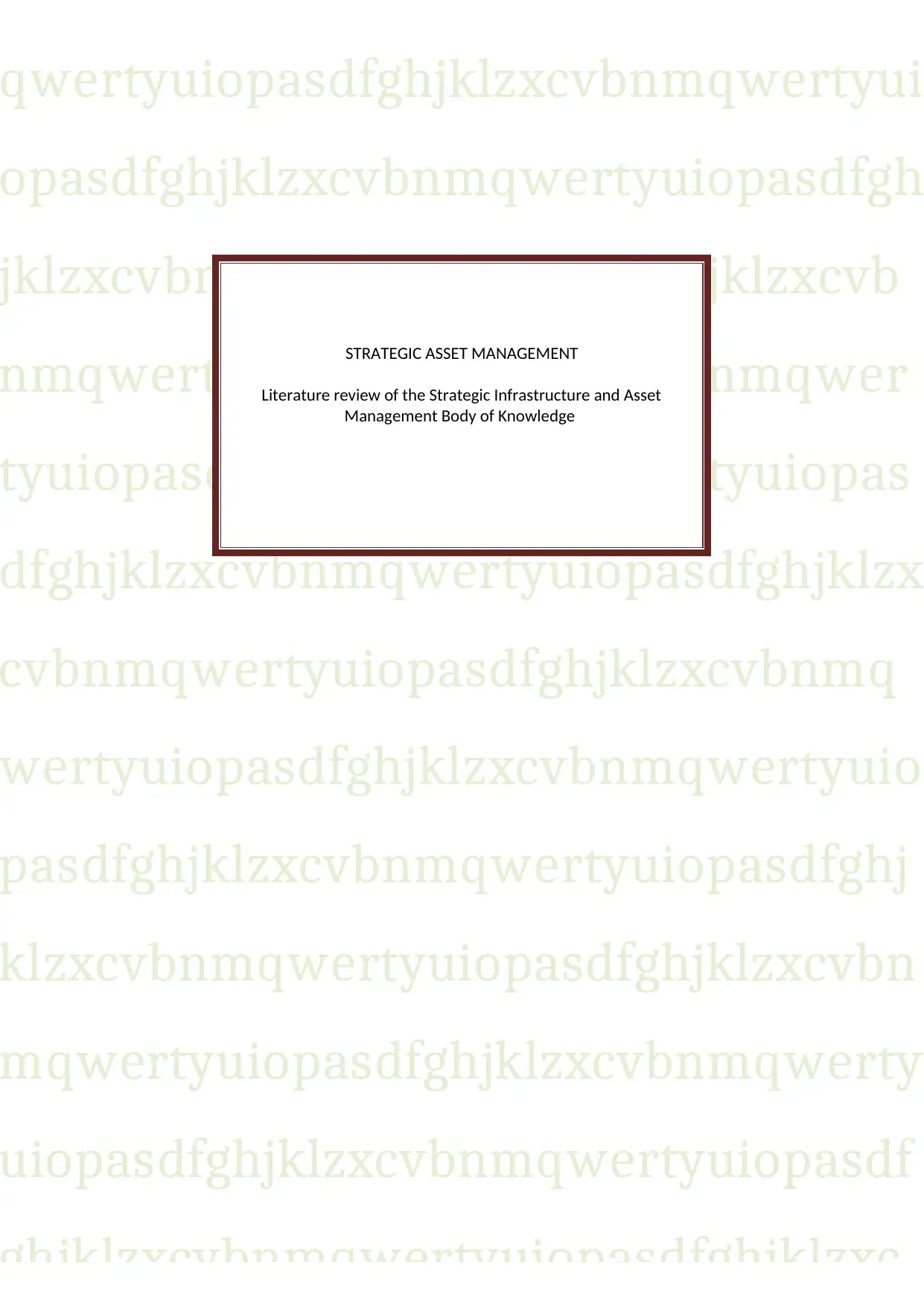
qwertyuiopasdfghjklzxcvbnmqwertyui
opasdfghjklzxcvbnmqwertyuiopasdfgh
jklzxcvbnmqwertyuiopasdfghjklzxcvb
nmqwertyuiopasdfghjklzxcvbnmqwer
tyuiopasdfghjklzxcvbnmqwertyuiopas
dfghjklzxcvbnmqwertyuiopasdfghjklzx
cvbnmqwertyuiopasdfghjklzxcvbnmq
wertyuiopasdfghjklzxcvbnmqwertyuio
pasdfghjklzxcvbnmqwertyuiopasdfghj
klzxcvbnmqwertyuiopasdfghjklzxcvbn
mqwertyuiopasdfghjklzxcvbnmqwerty
uiopasdfghjklzxcvbnmqwertyuiopasdf
ghjklzxcvbnmqwertyuiopasdfghjklzxc
STRATEGIC ASSET MANAGEMENT
Literature review of the Strategic Infrastructure and Asset
Management Body of Knowledge
opasdfghjklzxcvbnmqwertyuiopasdfgh
jklzxcvbnmqwertyuiopasdfghjklzxcvb
nmqwertyuiopasdfghjklzxcvbnmqwer
tyuiopasdfghjklzxcvbnmqwertyuiopas
dfghjklzxcvbnmqwertyuiopasdfghjklzx
cvbnmqwertyuiopasdfghjklzxcvbnmq
wertyuiopasdfghjklzxcvbnmqwertyuio
pasdfghjklzxcvbnmqwertyuiopasdfghj
klzxcvbnmqwertyuiopasdfghjklzxcvbn
mqwertyuiopasdfghjklzxcvbnmqwerty
uiopasdfghjklzxcvbnmqwertyuiopasdf
ghjklzxcvbnmqwertyuiopasdfghjklzxc
STRATEGIC ASSET MANAGEMENT
Literature review of the Strategic Infrastructure and Asset
Management Body of Knowledge
Paraphrase This Document
Need a fresh take? Get an instant paraphrase of this document with our AI Paraphraser
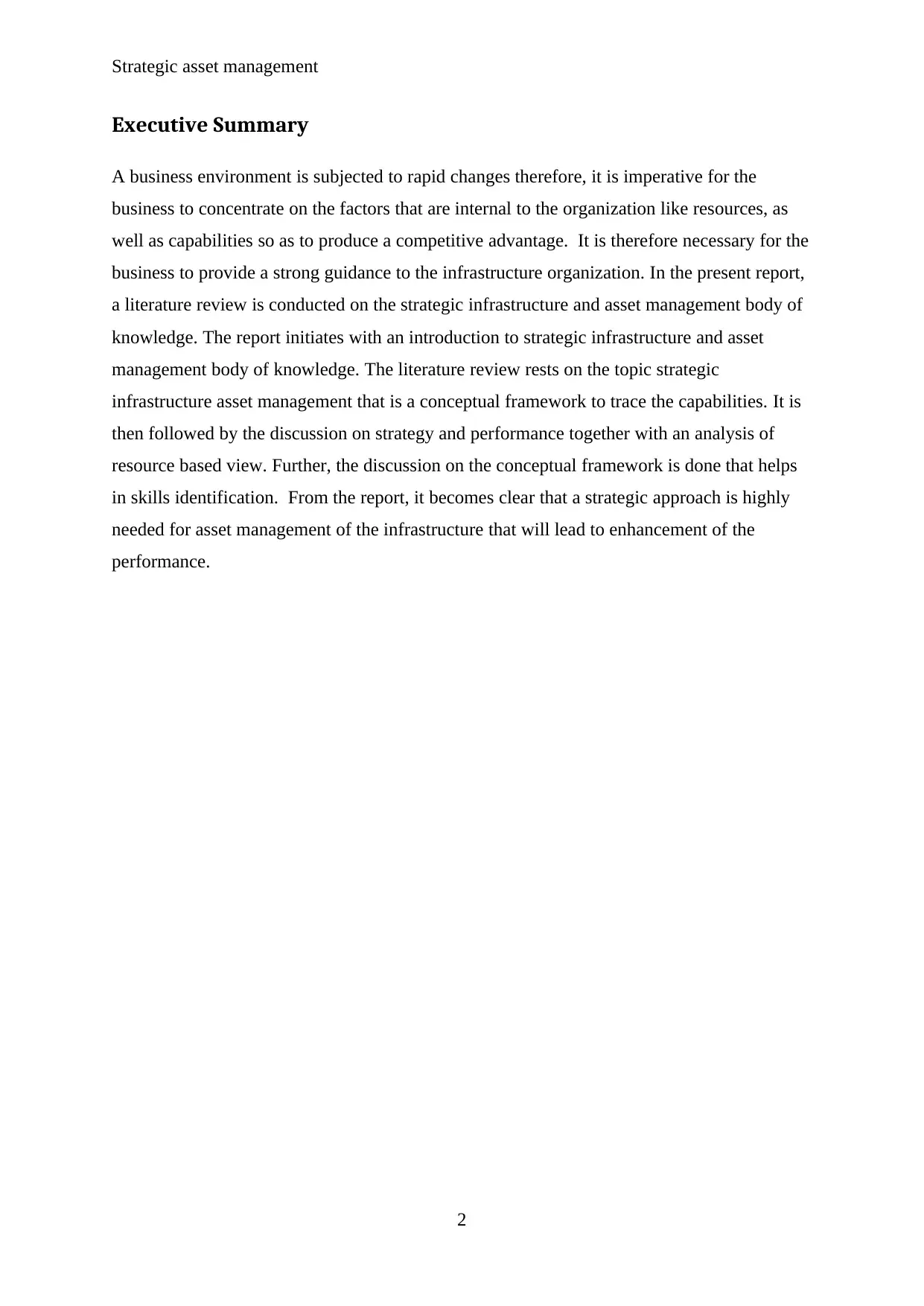
Strategic asset management
Executive Summary
A business environment is subjected to rapid changes therefore, it is imperative for the
business to concentrate on the factors that are internal to the organization like resources, as
well as capabilities so as to produce a competitive advantage. It is therefore necessary for the
business to provide a strong guidance to the infrastructure organization. In the present report,
a literature review is conducted on the strategic infrastructure and asset management body of
knowledge. The report initiates with an introduction to strategic infrastructure and asset
management body of knowledge. The literature review rests on the topic strategic
infrastructure asset management that is a conceptual framework to trace the capabilities. It is
then followed by the discussion on strategy and performance together with an analysis of
resource based view. Further, the discussion on the conceptual framework is done that helps
in skills identification. From the report, it becomes clear that a strategic approach is highly
needed for asset management of the infrastructure that will lead to enhancement of the
performance.
2
Executive Summary
A business environment is subjected to rapid changes therefore, it is imperative for the
business to concentrate on the factors that are internal to the organization like resources, as
well as capabilities so as to produce a competitive advantage. It is therefore necessary for the
business to provide a strong guidance to the infrastructure organization. In the present report,
a literature review is conducted on the strategic infrastructure and asset management body of
knowledge. The report initiates with an introduction to strategic infrastructure and asset
management body of knowledge. The literature review rests on the topic strategic
infrastructure asset management that is a conceptual framework to trace the capabilities. It is
then followed by the discussion on strategy and performance together with an analysis of
resource based view. Further, the discussion on the conceptual framework is done that helps
in skills identification. From the report, it becomes clear that a strategic approach is highly
needed for asset management of the infrastructure that will lead to enhancement of the
performance.
2

Strategic asset management
Contents
Literature review........................................................................................................................3
Introduction................................................................................................................................3
Strategy and Performance..........................................................................................................5
Importance of RBV for Organisation that pertains to Infrastructure.........................................6
A Conceptual Framework for Identification of the Skills..........................................................7
Step 1 – Role played by Asset Management......................................................................7
Step 2 –Alignment of the goals of Infrastructure Asset Management................................9
Step 3 –Identification of the process of Core Infrastructure Asset Management...............9
Step 4 - Core Infrastructure Management Processes and Delineate challenges...............11
Step 5 – Distil Infrastructure skills of Strategic Infrastructure Asset Management.........11
Conclusion................................................................................................................................13
References................................................................................................................................14
3
Contents
Literature review........................................................................................................................3
Introduction................................................................................................................................3
Strategy and Performance..........................................................................................................5
Importance of RBV for Organisation that pertains to Infrastructure.........................................6
A Conceptual Framework for Identification of the Skills..........................................................7
Step 1 – Role played by Asset Management......................................................................7
Step 2 –Alignment of the goals of Infrastructure Asset Management................................9
Step 3 –Identification of the process of Core Infrastructure Asset Management...............9
Step 4 - Core Infrastructure Management Processes and Delineate challenges...............11
Step 5 – Distil Infrastructure skills of Strategic Infrastructure Asset Management.........11
Conclusion................................................................................................................................13
References................................................................................................................................14
3
⊘ This is a preview!⊘
Do you want full access?
Subscribe today to unlock all pages.

Trusted by 1+ million students worldwide
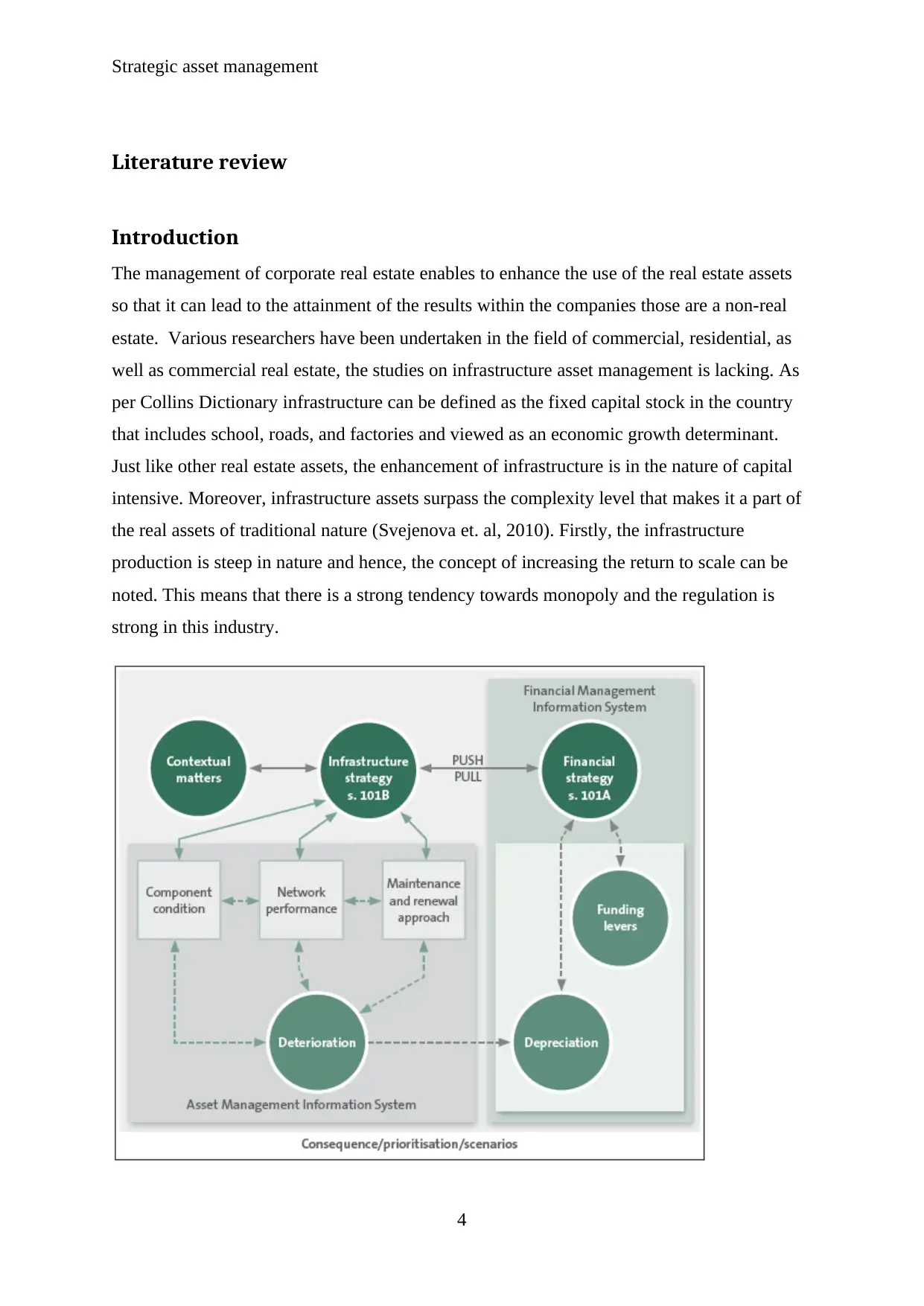
Strategic asset management
Literature review
Introduction
The management of corporate real estate enables to enhance the use of the real estate assets
so that it can lead to the attainment of the results within the companies those are a non-real
estate. Various researchers have been undertaken in the field of commercial, residential, as
well as commercial real estate, the studies on infrastructure asset management is lacking. As
per Collins Dictionary infrastructure can be defined as the fixed capital stock in the country
that includes school, roads, and factories and viewed as an economic growth determinant.
Just like other real estate assets, the enhancement of infrastructure is in the nature of capital
intensive. Moreover, infrastructure assets surpass the complexity level that makes it a part of
the real assets of traditional nature (Svejenova et. al, 2010). Firstly, the infrastructure
production is steep in nature and hence, the concept of increasing the return to scale can be
noted. This means that there is a strong tendency towards monopoly and the regulation is
strong in this industry.
4
Literature review
Introduction
The management of corporate real estate enables to enhance the use of the real estate assets
so that it can lead to the attainment of the results within the companies those are a non-real
estate. Various researchers have been undertaken in the field of commercial, residential, as
well as commercial real estate, the studies on infrastructure asset management is lacking. As
per Collins Dictionary infrastructure can be defined as the fixed capital stock in the country
that includes school, roads, and factories and viewed as an economic growth determinant.
Just like other real estate assets, the enhancement of infrastructure is in the nature of capital
intensive. Moreover, infrastructure assets surpass the complexity level that makes it a part of
the real assets of traditional nature (Svejenova et. al, 2010). Firstly, the infrastructure
production is steep in nature and hence, the concept of increasing the return to scale can be
noted. This means that there is a strong tendency towards monopoly and the regulation is
strong in this industry.
4
Paraphrase This Document
Need a fresh take? Get an instant paraphrase of this document with our AI Paraphraser

Strategic asset management
(Kennedy, 2007)
In the past few years, most of the industrialized world has witnessed immense challenges that
are linked to the management of the infrastructure assets. Such challenges contain the
infrastructure that is aging in nature, funding that is inadequate and short-term stress on the
political scenario, less information on the infrastructure, globalization and the requirement to
adhere to various demand of the stakeholders. This has to lead to a problem in terms of
performance for the infrastructure that is owned by the government (Brown, 2005). Further,
there have been many cases of the revival of the institutional options for the infrastructure
provision that contains a merge of competitive restructuring and development of methods of
regulatory nature (Kennedy, 2007).
When it comes to the changing scenario of the business, it is imperative for the infrastructure
organization to enhance the investments that are being made so that the capital can be
reduced together with the expenditure of operating nature and enhance the total performance
of the organization (Brown, 2005). Literature pertaining to strategic management suggests
that to shed light on the performance of the organization it is essential that the focus should
also be provided on the factors that are internal to the organization and even the structure of
the industry. As per Ravichandran et al. (2005) it is put to the argument that the theory of
resource-based and the extensions with the focus on the resources of the firm can lead to the
proper theoretical lens to evaluate how factors can be booster in terms of competitive
advantage. An organization can be a gainer and attain performance of a top-notch when it
contains the correct skills. In tune to this, the challenge remains to the organization in
association with the utilization of the resources in an optimal manner among the initiatives
that are competitive in nature so that skills of relevant nature can be attracted (Mckeo, 2008).
Therefore, it is the need of the hour to trace core capabilities that will make a difference in
terms of infrastructure, as well as the performance of the asset.
The main aim of the paper is to shed light on the conceptual framework so that identification
of the skills needs to be done when it comes to the management of the infrastructure assets.
This paper will shed light on the discussion required to adopt an approach that is strategic in
nature so that the performance can be enhanced. The literature we then examined in the light
of the prevalent situation. Based on the knowledge, an appropriate resource based view is
argued. Lastly, the conceptual framework is identified for strategic infrastructure.
5
(Kennedy, 2007)
In the past few years, most of the industrialized world has witnessed immense challenges that
are linked to the management of the infrastructure assets. Such challenges contain the
infrastructure that is aging in nature, funding that is inadequate and short-term stress on the
political scenario, less information on the infrastructure, globalization and the requirement to
adhere to various demand of the stakeholders. This has to lead to a problem in terms of
performance for the infrastructure that is owned by the government (Brown, 2005). Further,
there have been many cases of the revival of the institutional options for the infrastructure
provision that contains a merge of competitive restructuring and development of methods of
regulatory nature (Kennedy, 2007).
When it comes to the changing scenario of the business, it is imperative for the infrastructure
organization to enhance the investments that are being made so that the capital can be
reduced together with the expenditure of operating nature and enhance the total performance
of the organization (Brown, 2005). Literature pertaining to strategic management suggests
that to shed light on the performance of the organization it is essential that the focus should
also be provided on the factors that are internal to the organization and even the structure of
the industry. As per Ravichandran et al. (2005) it is put to the argument that the theory of
resource-based and the extensions with the focus on the resources of the firm can lead to the
proper theoretical lens to evaluate how factors can be booster in terms of competitive
advantage. An organization can be a gainer and attain performance of a top-notch when it
contains the correct skills. In tune to this, the challenge remains to the organization in
association with the utilization of the resources in an optimal manner among the initiatives
that are competitive in nature so that skills of relevant nature can be attracted (Mckeo, 2008).
Therefore, it is the need of the hour to trace core capabilities that will make a difference in
terms of infrastructure, as well as the performance of the asset.
The main aim of the paper is to shed light on the conceptual framework so that identification
of the skills needs to be done when it comes to the management of the infrastructure assets.
This paper will shed light on the discussion required to adopt an approach that is strategic in
nature so that the performance can be enhanced. The literature we then examined in the light
of the prevalent situation. Based on the knowledge, an appropriate resource based view is
argued. Lastly, the conceptual framework is identified for strategic infrastructure.
5
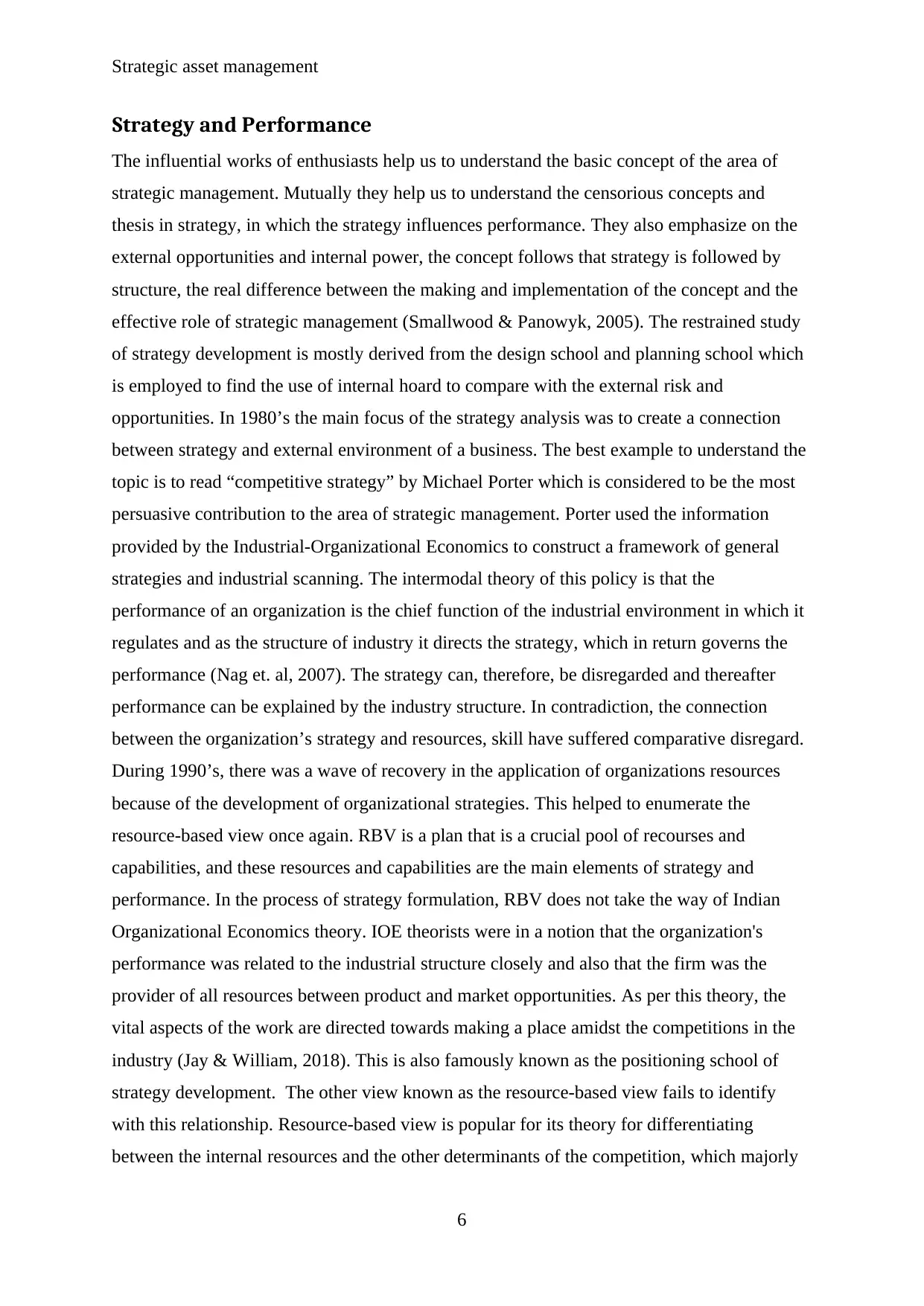
Strategic asset management
Strategy and Performance
The influential works of enthusiasts help us to understand the basic concept of the area of
strategic management. Mutually they help us to understand the censorious concepts and
thesis in strategy, in which the strategy influences performance. They also emphasize on the
external opportunities and internal power, the concept follows that strategy is followed by
structure, the real difference between the making and implementation of the concept and the
effective role of strategic management (Smallwood & Panowyk, 2005). The restrained study
of strategy development is mostly derived from the design school and planning school which
is employed to find the use of internal hoard to compare with the external risk and
opportunities. In 1980’s the main focus of the strategy analysis was to create a connection
between strategy and external environment of a business. The best example to understand the
topic is to read “competitive strategy” by Michael Porter which is considered to be the most
persuasive contribution to the area of strategic management. Porter used the information
provided by the Industrial-Organizational Economics to construct a framework of general
strategies and industrial scanning. The intermodal theory of this policy is that the
performance of an organization is the chief function of the industrial environment in which it
regulates and as the structure of industry it directs the strategy, which in return governs the
performance (Nag et. al, 2007). The strategy can, therefore, be disregarded and thereafter
performance can be explained by the industry structure. In contradiction, the connection
between the organization’s strategy and resources, skill have suffered comparative disregard.
During 1990’s, there was a wave of recovery in the application of organizations resources
because of the development of organizational strategies. This helped to enumerate the
resource-based view once again. RBV is a plan that is a crucial pool of recourses and
capabilities, and these resources and capabilities are the main elements of strategy and
performance. In the process of strategy formulation, RBV does not take the way of Indian
Organizational Economics theory. IOE theorists were in a notion that the organization's
performance was related to the industrial structure closely and also that the firm was the
provider of all resources between product and market opportunities. As per this theory, the
vital aspects of the work are directed towards making a place amidst the competitions in the
industry (Jay & William, 2018). This is also famously known as the positioning school of
strategy development. The other view known as the resource-based view fails to identify
with this relationship. Resource-based view is popular for its theory for differentiating
between the internal resources and the other determinants of the competition, which majorly
6
Strategy and Performance
The influential works of enthusiasts help us to understand the basic concept of the area of
strategic management. Mutually they help us to understand the censorious concepts and
thesis in strategy, in which the strategy influences performance. They also emphasize on the
external opportunities and internal power, the concept follows that strategy is followed by
structure, the real difference between the making and implementation of the concept and the
effective role of strategic management (Smallwood & Panowyk, 2005). The restrained study
of strategy development is mostly derived from the design school and planning school which
is employed to find the use of internal hoard to compare with the external risk and
opportunities. In 1980’s the main focus of the strategy analysis was to create a connection
between strategy and external environment of a business. The best example to understand the
topic is to read “competitive strategy” by Michael Porter which is considered to be the most
persuasive contribution to the area of strategic management. Porter used the information
provided by the Industrial-Organizational Economics to construct a framework of general
strategies and industrial scanning. The intermodal theory of this policy is that the
performance of an organization is the chief function of the industrial environment in which it
regulates and as the structure of industry it directs the strategy, which in return governs the
performance (Nag et. al, 2007). The strategy can, therefore, be disregarded and thereafter
performance can be explained by the industry structure. In contradiction, the connection
between the organization’s strategy and resources, skill have suffered comparative disregard.
During 1990’s, there was a wave of recovery in the application of organizations resources
because of the development of organizational strategies. This helped to enumerate the
resource-based view once again. RBV is a plan that is a crucial pool of recourses and
capabilities, and these resources and capabilities are the main elements of strategy and
performance. In the process of strategy formulation, RBV does not take the way of Indian
Organizational Economics theory. IOE theorists were in a notion that the organization's
performance was related to the industrial structure closely and also that the firm was the
provider of all resources between product and market opportunities. As per this theory, the
vital aspects of the work are directed towards making a place amidst the competitions in the
industry (Jay & William, 2018). This is also famously known as the positioning school of
strategy development. The other view known as the resource-based view fails to identify
with this relationship. Resource-based view is popular for its theory for differentiating
between the internal resources and the other determinants of the competition, which majorly
6
⊘ This is a preview!⊘
Do you want full access?
Subscribe today to unlock all pages.

Trusted by 1+ million students worldwide
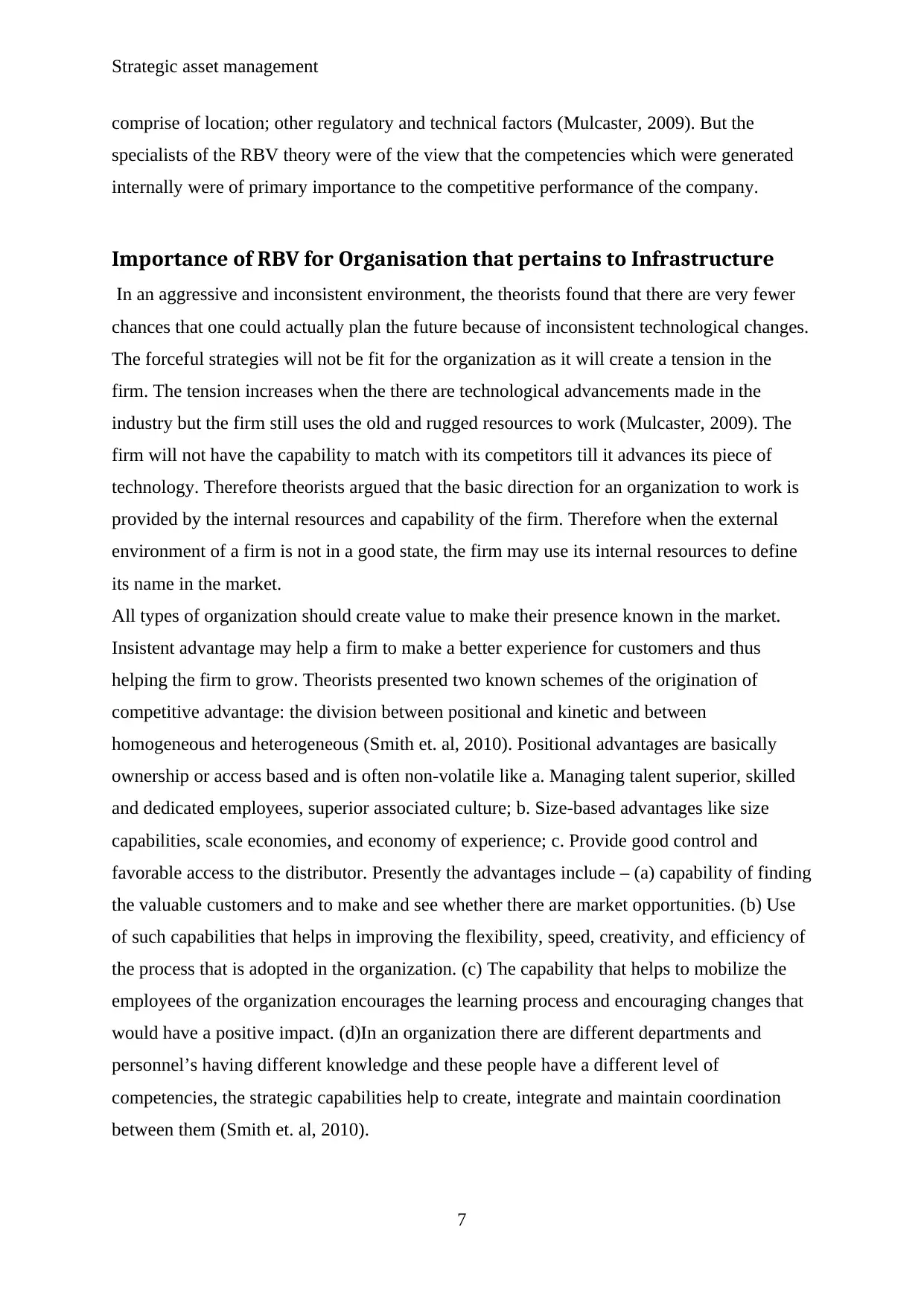
Strategic asset management
comprise of location; other regulatory and technical factors (Mulcaster, 2009). But the
specialists of the RBV theory were of the view that the competencies which were generated
internally were of primary importance to the competitive performance of the company.
Importance of RBV for Organisation that pertains to Infrastructure
In an aggressive and inconsistent environment, the theorists found that there are very fewer
chances that one could actually plan the future because of inconsistent technological changes.
The forceful strategies will not be fit for the organization as it will create a tension in the
firm. The tension increases when the there are technological advancements made in the
industry but the firm still uses the old and rugged resources to work (Mulcaster, 2009). The
firm will not have the capability to match with its competitors till it advances its piece of
technology. Therefore theorists argued that the basic direction for an organization to work is
provided by the internal resources and capability of the firm. Therefore when the external
environment of a firm is not in a good state, the firm may use its internal resources to define
its name in the market.
All types of organization should create value to make their presence known in the market.
Insistent advantage may help a firm to make a better experience for customers and thus
helping the firm to grow. Theorists presented two known schemes of the origination of
competitive advantage: the division between positional and kinetic and between
homogeneous and heterogeneous (Smith et. al, 2010). Positional advantages are basically
ownership or access based and is often non-volatile like a. Managing talent superior, skilled
and dedicated employees, superior associated culture; b. Size-based advantages like size
capabilities, scale economies, and economy of experience; c. Provide good control and
favorable access to the distributor. Presently the advantages include – (a) capability of finding
the valuable customers and to make and see whether there are market opportunities. (b) Use
of such capabilities that helps in improving the flexibility, speed, creativity, and efficiency of
the process that is adopted in the organization. (c) The capability that helps to mobilize the
employees of the organization encourages the learning process and encouraging changes that
would have a positive impact. (d)In an organization there are different departments and
personnel’s having different knowledge and these people have a different level of
competencies, the strategic capabilities help to create, integrate and maintain coordination
between them (Smith et. al, 2010).
7
comprise of location; other regulatory and technical factors (Mulcaster, 2009). But the
specialists of the RBV theory were of the view that the competencies which were generated
internally were of primary importance to the competitive performance of the company.
Importance of RBV for Organisation that pertains to Infrastructure
In an aggressive and inconsistent environment, the theorists found that there are very fewer
chances that one could actually plan the future because of inconsistent technological changes.
The forceful strategies will not be fit for the organization as it will create a tension in the
firm. The tension increases when the there are technological advancements made in the
industry but the firm still uses the old and rugged resources to work (Mulcaster, 2009). The
firm will not have the capability to match with its competitors till it advances its piece of
technology. Therefore theorists argued that the basic direction for an organization to work is
provided by the internal resources and capability of the firm. Therefore when the external
environment of a firm is not in a good state, the firm may use its internal resources to define
its name in the market.
All types of organization should create value to make their presence known in the market.
Insistent advantage may help a firm to make a better experience for customers and thus
helping the firm to grow. Theorists presented two known schemes of the origination of
competitive advantage: the division between positional and kinetic and between
homogeneous and heterogeneous (Smith et. al, 2010). Positional advantages are basically
ownership or access based and is often non-volatile like a. Managing talent superior, skilled
and dedicated employees, superior associated culture; b. Size-based advantages like size
capabilities, scale economies, and economy of experience; c. Provide good control and
favorable access to the distributor. Presently the advantages include – (a) capability of finding
the valuable customers and to make and see whether there are market opportunities. (b) Use
of such capabilities that helps in improving the flexibility, speed, creativity, and efficiency of
the process that is adopted in the organization. (c) The capability that helps to mobilize the
employees of the organization encourages the learning process and encouraging changes that
would have a positive impact. (d)In an organization there are different departments and
personnel’s having different knowledge and these people have a different level of
competencies, the strategic capabilities help to create, integrate and maintain coordination
between them (Smith et. al, 2010).
7
Paraphrase This Document
Need a fresh take? Get an instant paraphrase of this document with our AI Paraphraser

Strategic asset management
In the recent years, it has been observed that there were many challenges and difficulties
faced by the infrastructure due to deregulation and privatization. This has also resulted in
alteration of the business dynamics and also there existed certain uncertainties. It was
suggested that there would be improved, sustainable and superior performance observed due
to the kinetic advantage. There always exists a rival for the company in the market which can
either compete in the same manner (homogenous) or different manner (heterogeneous). It
was seen in the past that the infrastructure organization has always adopted homogenous
competition. However, in the times of privatization, it was observed that the company
competed heterogeneously, this was because during this time the entire attention was paid to
the customers and the organizations were accountable for the results.
In the overall discussion, we can say that there lies a great importance of the RBV paradigm
in making the infrastructural organization better. The RBV concept comprises of the kinetic
advantage as well as the heterogeneous advantage. In addition, we will also see that there
will be no constant competitive advantage in the long run because the organization will start
imitating the products of others (Zehir et. al, 2006). The RBV has helped in developing the
framework of the organization that has resulted in the improvement of their performance.
A Conceptual Framework for Identification of the Skills
Step 1 – Role played by Asset Management
Asset management is the area which always has a scope of betterment. It has been said that
while implementing asset management one should always keep the thought of improvement
in mind so that the effects of the procedure can be managed steadily. Asset management has
been said to have a complex nature, in order to simplify these complexities, we divided the
infrastructure businesses into three major components as the asset owner, asset manager and
lastly the service provider (Klueger, 2012). This classification enables an entity to have
exclusive knowledge in one's department, resulting in perfection due to practice. This helps
divide the responsibilities into planning and execution, resulting in the better response. We
have discussed the roles and responsibilities of the components below:
8
In the recent years, it has been observed that there were many challenges and difficulties
faced by the infrastructure due to deregulation and privatization. This has also resulted in
alteration of the business dynamics and also there existed certain uncertainties. It was
suggested that there would be improved, sustainable and superior performance observed due
to the kinetic advantage. There always exists a rival for the company in the market which can
either compete in the same manner (homogenous) or different manner (heterogeneous). It
was seen in the past that the infrastructure organization has always adopted homogenous
competition. However, in the times of privatization, it was observed that the company
competed heterogeneously, this was because during this time the entire attention was paid to
the customers and the organizations were accountable for the results.
In the overall discussion, we can say that there lies a great importance of the RBV paradigm
in making the infrastructural organization better. The RBV concept comprises of the kinetic
advantage as well as the heterogeneous advantage. In addition, we will also see that there
will be no constant competitive advantage in the long run because the organization will start
imitating the products of others (Zehir et. al, 2006). The RBV has helped in developing the
framework of the organization that has resulted in the improvement of their performance.
A Conceptual Framework for Identification of the Skills
Step 1 – Role played by Asset Management
Asset management is the area which always has a scope of betterment. It has been said that
while implementing asset management one should always keep the thought of improvement
in mind so that the effects of the procedure can be managed steadily. Asset management has
been said to have a complex nature, in order to simplify these complexities, we divided the
infrastructure businesses into three major components as the asset owner, asset manager and
lastly the service provider (Klueger, 2012). This classification enables an entity to have
exclusive knowledge in one's department, resulting in perfection due to practice. This helps
divide the responsibilities into planning and execution, resulting in the better response. We
have discussed the roles and responsibilities of the components below:
8
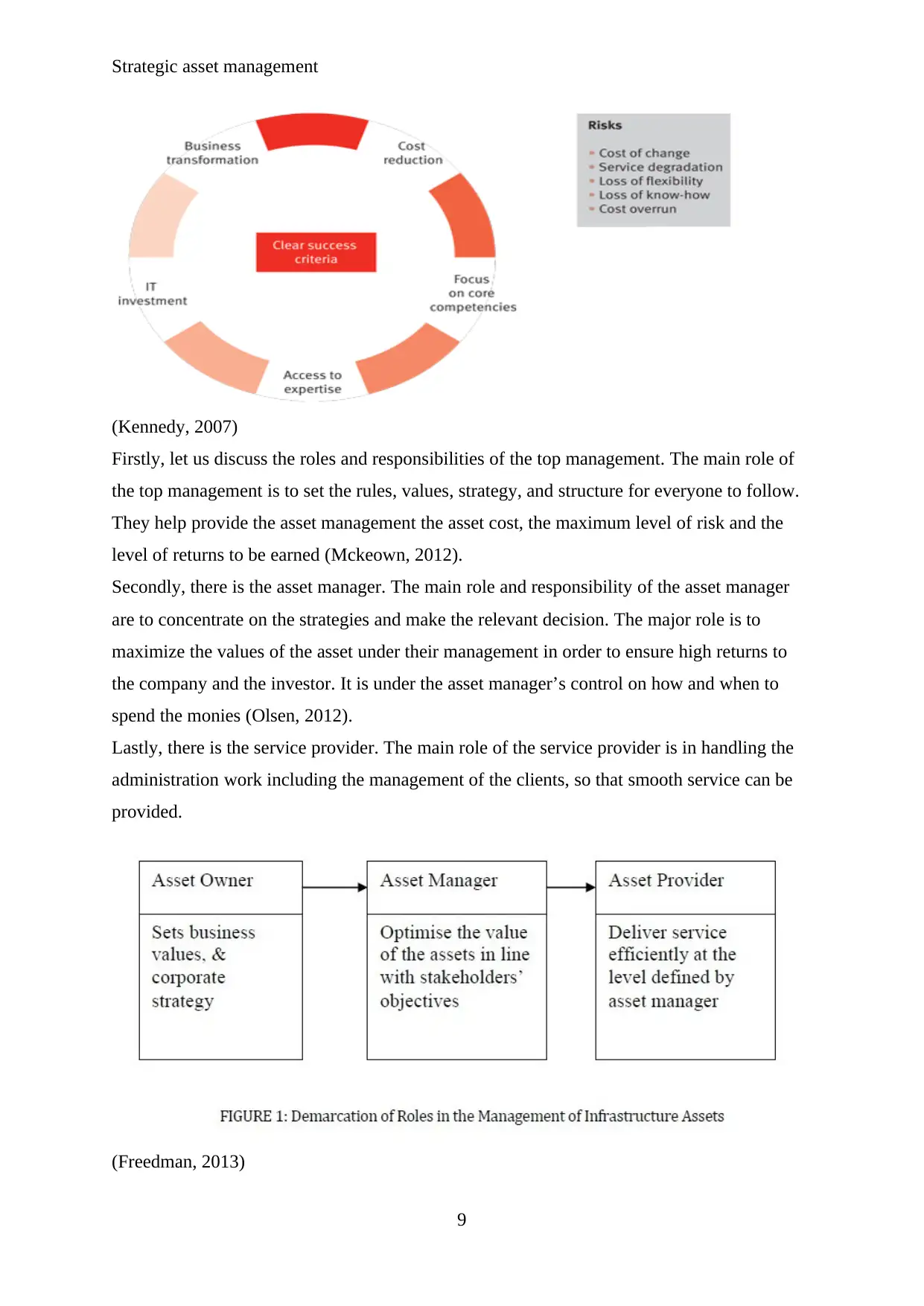
Strategic asset management
(Kennedy, 2007)
Firstly, let us discuss the roles and responsibilities of the top management. The main role of
the top management is to set the rules, values, strategy, and structure for everyone to follow.
They help provide the asset management the asset cost, the maximum level of risk and the
level of returns to be earned (Mckeown, 2012).
Secondly, there is the asset manager. The main role and responsibility of the asset manager
are to concentrate on the strategies and make the relevant decision. The major role is to
maximize the values of the asset under their management in order to ensure high returns to
the company and the investor. It is under the asset manager’s control on how and when to
spend the monies (Olsen, 2012).
Lastly, there is the service provider. The main role of the service provider is in handling the
administration work including the management of the clients, so that smooth service can be
provided.
(Freedman, 2013)
9
(Kennedy, 2007)
Firstly, let us discuss the roles and responsibilities of the top management. The main role of
the top management is to set the rules, values, strategy, and structure for everyone to follow.
They help provide the asset management the asset cost, the maximum level of risk and the
level of returns to be earned (Mckeown, 2012).
Secondly, there is the asset manager. The main role and responsibility of the asset manager
are to concentrate on the strategies and make the relevant decision. The major role is to
maximize the values of the asset under their management in order to ensure high returns to
the company and the investor. It is under the asset manager’s control on how and when to
spend the monies (Olsen, 2012).
Lastly, there is the service provider. The main role of the service provider is in handling the
administration work including the management of the clients, so that smooth service can be
provided.
(Freedman, 2013)
9
⊘ This is a preview!⊘
Do you want full access?
Subscribe today to unlock all pages.

Trusted by 1+ million students worldwide
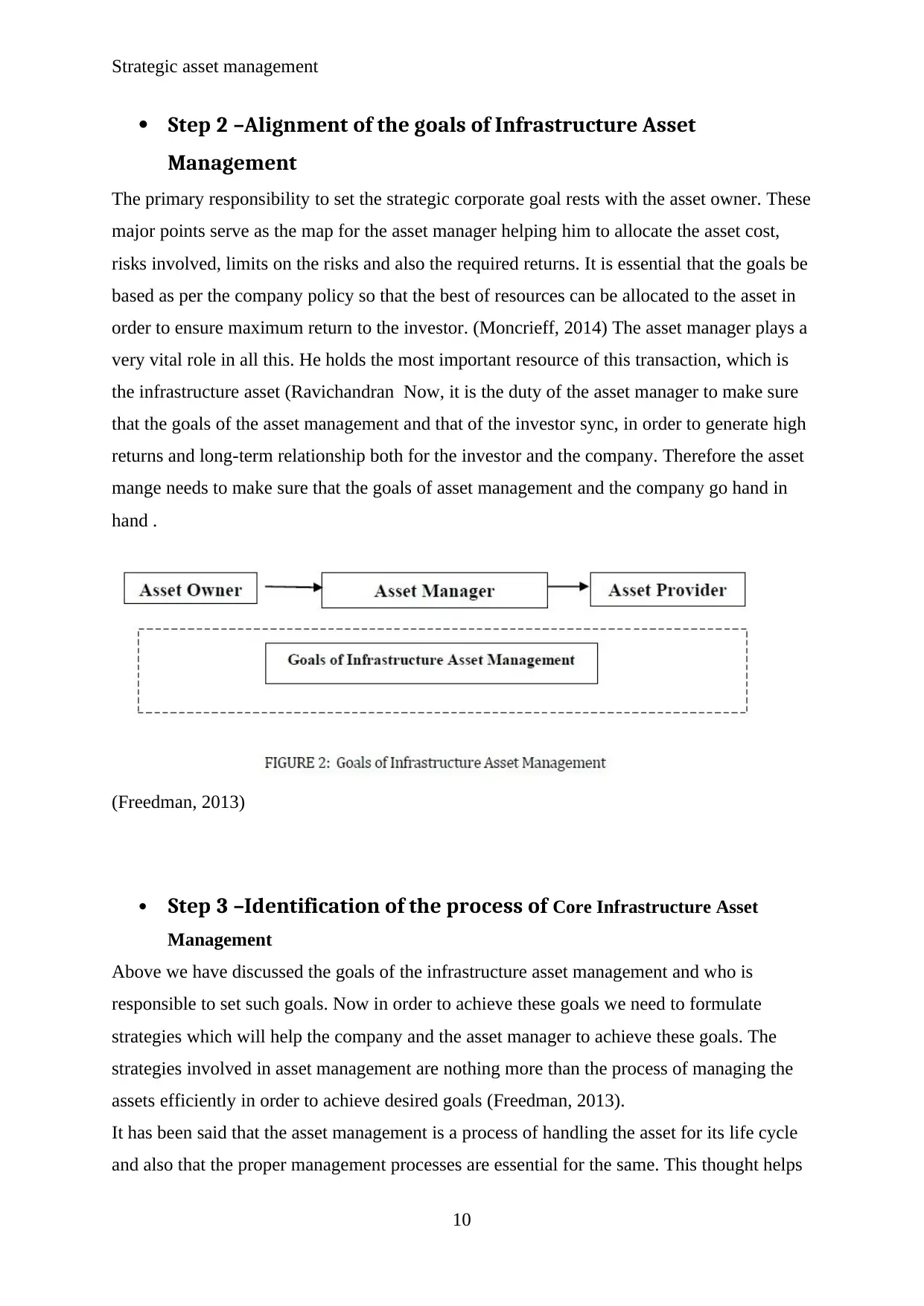
Strategic asset management
Step 2 –Alignment of the goals of Infrastructure Asset
Management
The primary responsibility to set the strategic corporate goal rests with the asset owner. These
major points serve as the map for the asset manager helping him to allocate the asset cost,
risks involved, limits on the risks and also the required returns. It is essential that the goals be
based as per the company policy so that the best of resources can be allocated to the asset in
order to ensure maximum return to the investor. (Moncrieff, 2014) The asset manager plays a
very vital role in all this. He holds the most important resource of this transaction, which is
the infrastructure asset (Ravichandran Now, it is the duty of the asset manager to make sure
that the goals of the asset management and that of the investor sync, in order to generate high
returns and long-term relationship both for the investor and the company. Therefore the asset
mange needs to make sure that the goals of asset management and the company go hand in
hand .
(Freedman, 2013)
Step 3 –Identification of the process of Core Infrastructure Asset
Management
Above we have discussed the goals of the infrastructure asset management and who is
responsible to set such goals. Now in order to achieve these goals we need to formulate
strategies which will help the company and the asset manager to achieve these goals. The
strategies involved in asset management are nothing more than the process of managing the
assets efficiently in order to achieve desired goals (Freedman, 2013).
It has been said that the asset management is a process of handling the asset for its life cycle
and also that the proper management processes are essential for the same. This thought helps
10
Step 2 –Alignment of the goals of Infrastructure Asset
Management
The primary responsibility to set the strategic corporate goal rests with the asset owner. These
major points serve as the map for the asset manager helping him to allocate the asset cost,
risks involved, limits on the risks and also the required returns. It is essential that the goals be
based as per the company policy so that the best of resources can be allocated to the asset in
order to ensure maximum return to the investor. (Moncrieff, 2014) The asset manager plays a
very vital role in all this. He holds the most important resource of this transaction, which is
the infrastructure asset (Ravichandran Now, it is the duty of the asset manager to make sure
that the goals of the asset management and that of the investor sync, in order to generate high
returns and long-term relationship both for the investor and the company. Therefore the asset
mange needs to make sure that the goals of asset management and the company go hand in
hand .
(Freedman, 2013)
Step 3 –Identification of the process of Core Infrastructure Asset
Management
Above we have discussed the goals of the infrastructure asset management and who is
responsible to set such goals. Now in order to achieve these goals we need to formulate
strategies which will help the company and the asset manager to achieve these goals. The
strategies involved in asset management are nothing more than the process of managing the
assets efficiently in order to achieve desired goals (Freedman, 2013).
It has been said that the asset management is a process of handling the asset for its life cycle
and also that the proper management processes are essential for the same. This thought helps
10
Paraphrase This Document
Need a fresh take? Get an instant paraphrase of this document with our AI Paraphraser
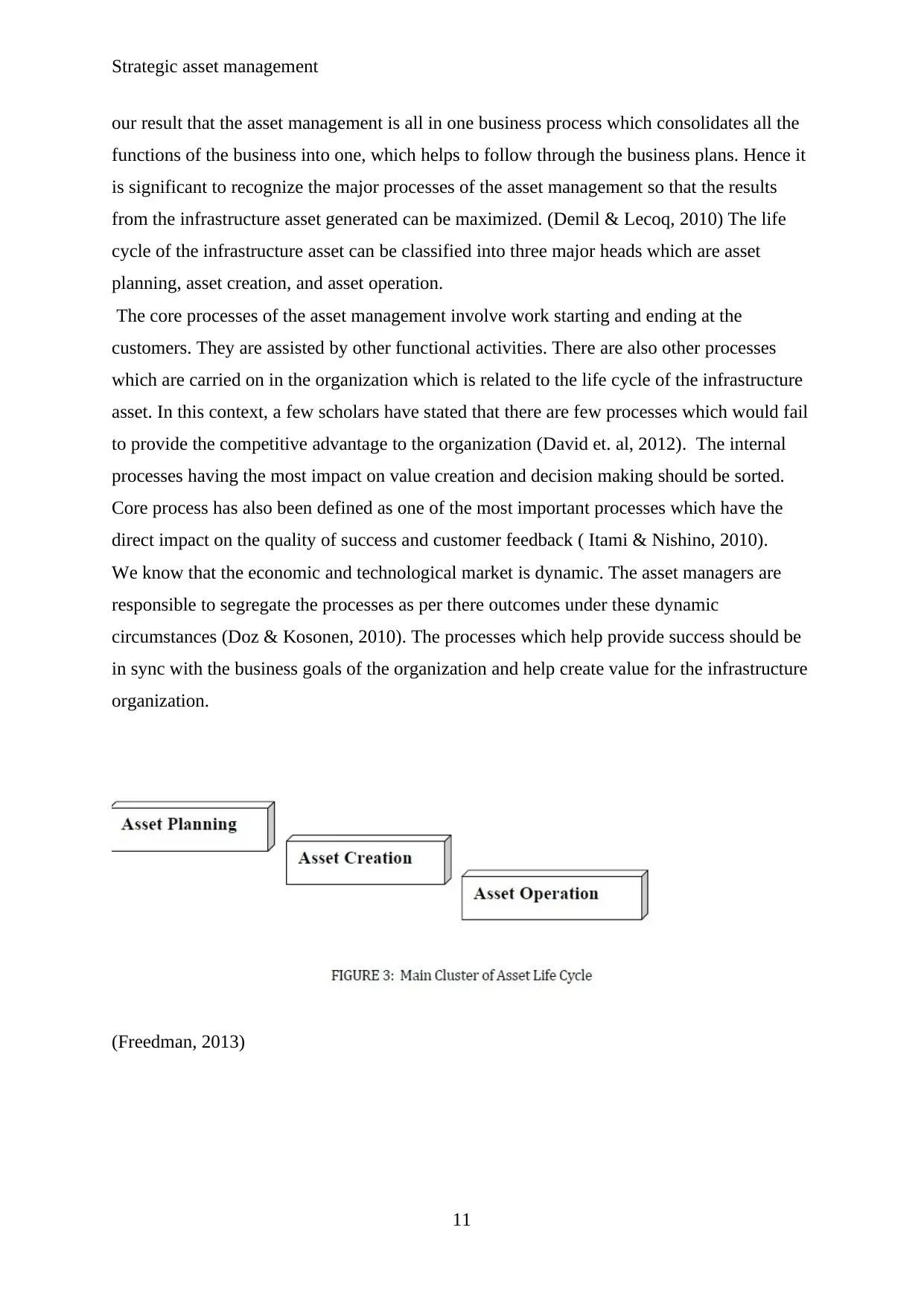
Strategic asset management
our result that the asset management is all in one business process which consolidates all the
functions of the business into one, which helps to follow through the business plans. Hence it
is significant to recognize the major processes of the asset management so that the results
from the infrastructure asset generated can be maximized. (Demil & Lecoq, 2010) The life
cycle of the infrastructure asset can be classified into three major heads which are asset
planning, asset creation, and asset operation.
The core processes of the asset management involve work starting and ending at the
customers. They are assisted by other functional activities. There are also other processes
which are carried on in the organization which is related to the life cycle of the infrastructure
asset. In this context, a few scholars have stated that there are few processes which would fail
to provide the competitive advantage to the organization (David et. al, 2012). The internal
processes having the most impact on value creation and decision making should be sorted.
Core process has also been defined as one of the most important processes which have the
direct impact on the quality of success and customer feedback ( Itami & Nishino, 2010).
We know that the economic and technological market is dynamic. The asset managers are
responsible to segregate the processes as per there outcomes under these dynamic
circumstances (Doz & Kosonen, 2010). The processes which help provide success should be
in sync with the business goals of the organization and help create value for the infrastructure
organization.
(Freedman, 2013)
11
our result that the asset management is all in one business process which consolidates all the
functions of the business into one, which helps to follow through the business plans. Hence it
is significant to recognize the major processes of the asset management so that the results
from the infrastructure asset generated can be maximized. (Demil & Lecoq, 2010) The life
cycle of the infrastructure asset can be classified into three major heads which are asset
planning, asset creation, and asset operation.
The core processes of the asset management involve work starting and ending at the
customers. They are assisted by other functional activities. There are also other processes
which are carried on in the organization which is related to the life cycle of the infrastructure
asset. In this context, a few scholars have stated that there are few processes which would fail
to provide the competitive advantage to the organization (David et. al, 2012). The internal
processes having the most impact on value creation and decision making should be sorted.
Core process has also been defined as one of the most important processes which have the
direct impact on the quality of success and customer feedback ( Itami & Nishino, 2010).
We know that the economic and technological market is dynamic. The asset managers are
responsible to segregate the processes as per there outcomes under these dynamic
circumstances (Doz & Kosonen, 2010). The processes which help provide success should be
in sync with the business goals of the organization and help create value for the infrastructure
organization.
(Freedman, 2013)
11
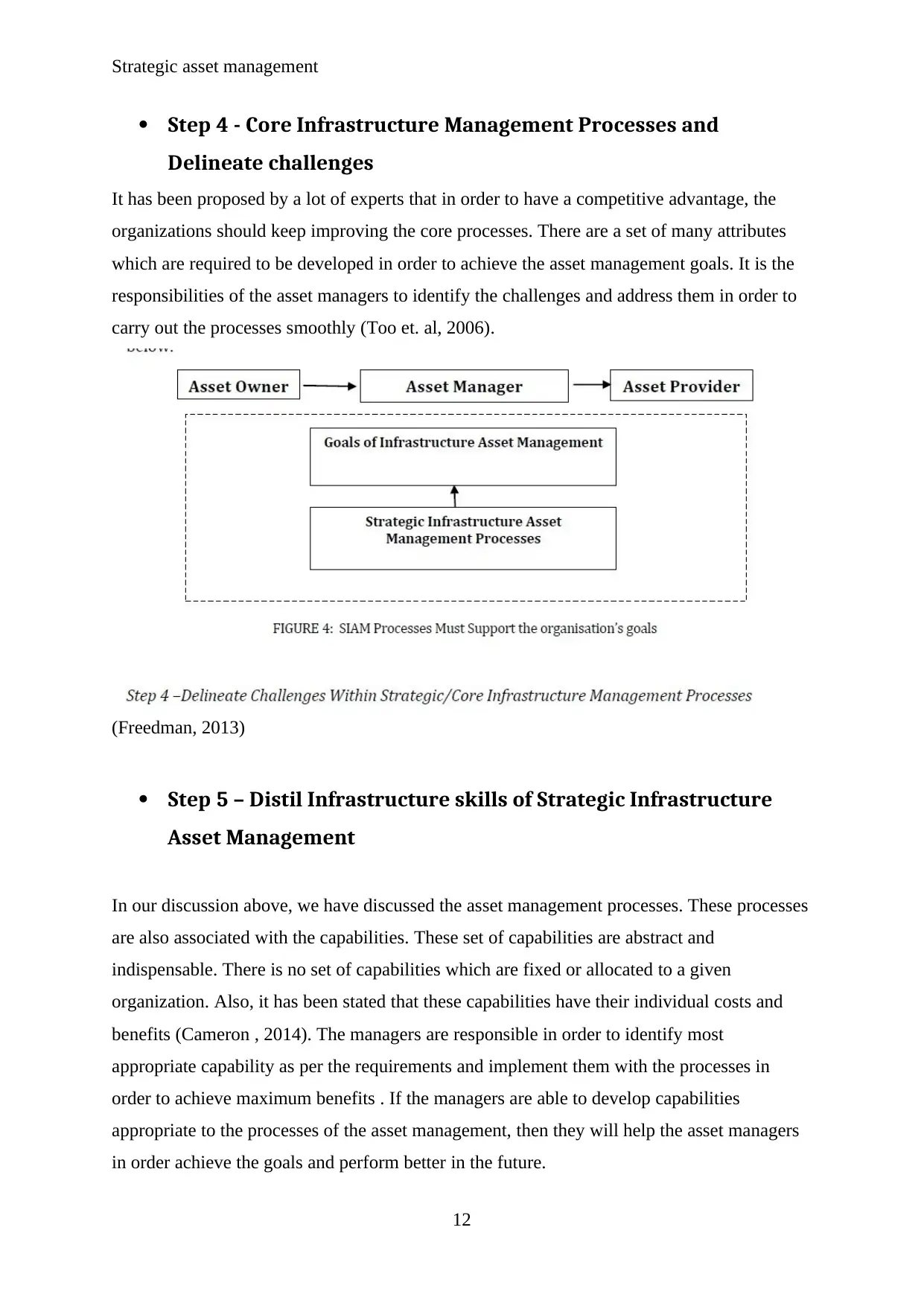
Strategic asset management
Step 4 - Core Infrastructure Management Processes and
Delineate challenges
It has been proposed by a lot of experts that in order to have a competitive advantage, the
organizations should keep improving the core processes. There are a set of many attributes
which are required to be developed in order to achieve the asset management goals. It is the
responsibilities of the asset managers to identify the challenges and address them in order to
carry out the processes smoothly (Too et. al, 2006).
(Freedman, 2013)
Step 5 – Distil Infrastructure skills of Strategic Infrastructure
Asset Management
In our discussion above, we have discussed the asset management processes. These processes
are also associated with the capabilities. These set of capabilities are abstract and
indispensable. There is no set of capabilities which are fixed or allocated to a given
organization. Also, it has been stated that these capabilities have their individual costs and
benefits (Cameron , 2014). The managers are responsible in order to identify most
appropriate capability as per the requirements and implement them with the processes in
order to achieve maximum benefits . If the managers are able to develop capabilities
appropriate to the processes of the asset management, then they will help the asset managers
in order achieve the goals and perform better in the future.
12
Step 4 - Core Infrastructure Management Processes and
Delineate challenges
It has been proposed by a lot of experts that in order to have a competitive advantage, the
organizations should keep improving the core processes. There are a set of many attributes
which are required to be developed in order to achieve the asset management goals. It is the
responsibilities of the asset managers to identify the challenges and address them in order to
carry out the processes smoothly (Too et. al, 2006).
(Freedman, 2013)
Step 5 – Distil Infrastructure skills of Strategic Infrastructure
Asset Management
In our discussion above, we have discussed the asset management processes. These processes
are also associated with the capabilities. These set of capabilities are abstract and
indispensable. There is no set of capabilities which are fixed or allocated to a given
organization. Also, it has been stated that these capabilities have their individual costs and
benefits (Cameron , 2014). The managers are responsible in order to identify most
appropriate capability as per the requirements and implement them with the processes in
order to achieve maximum benefits . If the managers are able to develop capabilities
appropriate to the processes of the asset management, then they will help the asset managers
in order achieve the goals and perform better in the future.
12
⊘ This is a preview!⊘
Do you want full access?
Subscribe today to unlock all pages.

Trusted by 1+ million students worldwide
1 out of 16
Related Documents
Your All-in-One AI-Powered Toolkit for Academic Success.
+13062052269
info@desklib.com
Available 24*7 on WhatsApp / Email
![[object Object]](/_next/static/media/star-bottom.7253800d.svg)
Unlock your academic potential
Copyright © 2020–2025 A2Z Services. All Rights Reserved. Developed and managed by ZUCOL.





